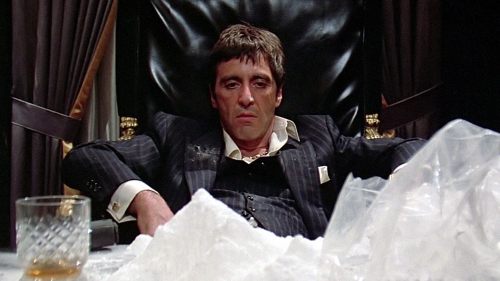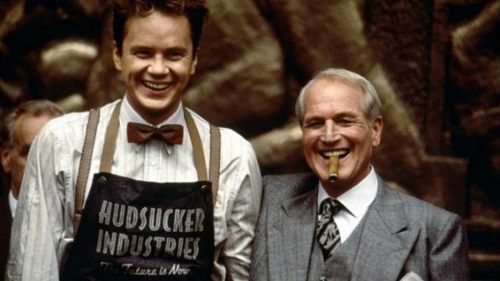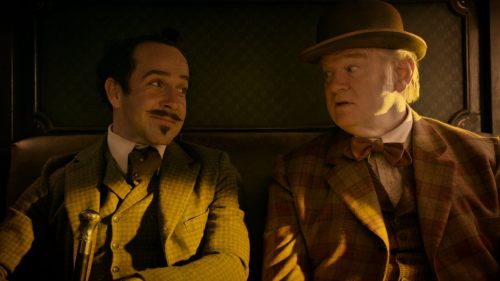Broad Cinema: An Arizona Of The Mind - On RAISING ARIZONA
From Alice Guy-Blaché to Ava Duvernay, women have been integral to cinema for the last 120 years. Broad Cinema is a new column that will feature women who worked on films that are playing this month at the Alamo Drafthouse. From movie stars to directors, from cinematographers to key grips, Broad Cinema will shine a spotlight on women in every level of motion picture production throughout history.
This week, we're honoring Holly Hunter. Live in an Alamo market? Get your tickets to the Raising Arizona Movie Party here!
A Harley-riding baby hunter straight out of Mad Max, a nightmare even by Wasteland standards. A convenience-store stickup for diapers culminating in one of the best car chases in cinematic history. The monstrous, bellowing birth of John Goodman and William Forsythe out of a sewer line into a prison yard during a thunderstorm. Nicolas Cage with a Woody Woodpecker tattoo and a Woody Woodpecker hairstyle that grows wilder as the plot gets crazier. And our introduction to national treasure Holly Hunter in her first leading feature-film role. Raising Arizona yodeled its way into collective consciousness in 1987. At the time some critics didn’t cotton to it, but they were wrong. Raising Arizona was The Road Warrior, High Noon, Looney Tunes, with DP Barry Sonnenfeld’s zooming, baby’s eye view, The Evil Dead-inspired camerawork meant to “refine the spirit of animation you find in pinball machines” in the words of Ethan Coen. It was a parody of the Western, of Reagan’s America, of pop psychology. Raising Arizona wasn’t just a farce, or a film “full of technical expertise but [with] no life of its own” as Vincent Canby once wrote — it was a comedy with wit, and heart, and pathos.
When critics labeled them “film noir” after their debut Blood Simple, the Coens sought to make a film that Ethan called “sui generis,” and they succeeded. Joel and Ethan began writing Raising Arizona in May 1985 with a Smith-Corona electric typewriter in a one room with dirty windows where they were still living hand-to-mouth. The script was about a repeat offender named H.I. McDunnough (Cage) and Edwina or “Ed” (Hunter), the cop who takes his mugshots. They fall in love, and marry, and discover they can’t have children. In a perfect confluence of the couple’s interests — Hi’s recidivism, Ed’s desire to have a child — they decide to steal a baby from Trey Wilson’s Nathan Arizona, an unpainted-furniture magnate whose wife has just given birth to quintuplets. Fifteen babies were required to play the five Arizona quints. But the babies kept improvising, and learning how to walk. Joel Coen explained to American Film, “We kept firing babies when they wouldn’t behave. And they didn’t even know they were being fired, that’s what was so pathetic about it.”
Raising Arizona begins with Holly Hunter. The Coens had originally wanted to cast Hunter as the lead in Blood Simple, but Ed would be her first leading role, a character expressly written for her. Ethan Coen told Positif: “We wanted to use Holly Hunter, who has been a friend of ours for a long time. So it really wasn’t the story that was the origin of the project, but Holly Hunter, her personality and, by extension, the character we had conceived for her to play.” Ethan mentioned that one image stuck in their minds as they wrote the screenplay: “seeing Holly shouting orders at the prisoners.” Hunter loved the script and felt that Ed took pride in “militaristic discipline,” which is why it made sense to her that her character would fall for Hi: “he doesn’t play games.” Hunter believed Ed’s implacable desire for a child is “bigger than anything she’s confronted in her life.”
“H.I. McDunnough. Call me Hi,” is Raising Arizona’s “Call me Ishmael.” The film is set in Arizona, but it also exists in Hi’s own world, a subjective reality that he narrates to us like a storybook. Joel Coen explained that the characters’ flowery dialect derives from “the kind of reading they probably did: the Bible, newspapers.” Hi is torn between domesticity and criminality, his love for Ed and his passion for robbing convenience stores. The Coens were most interested in a character who yearns for the American dream, a nuclear family and stability, yet “feels outside the law.” Hi’s inner turmoil and story arc are reflected in the wildness of his hair. Almost all of Cage’s character suggestions were shot down by the Coens — Cage claimed they had an “autocratic nature” — and his evolving hair was the only creative choice he was allowed. Blood Simple star M. Emmet Walsh explained: “By the time you get on [the Coens’] set, they’ve got it worked out like a commercial shoot — preplanned to the nth degree. They never went to work without knowing what they were up to. To the point where if you made a suggestion, it almost got in the way.”
Gale and Evelle Snopes are the story’s Laurel and Hardy, like something out of a Flannery O’Connor short story, or long-lost members of William Faulkner’s Snopes family. The Coens cast Goodman and Forsythe because they looked like “grownup babies.” Raising Arizona was John Goodman’s debut as an agent of chaos in Ethan’s and Joel’s filmography, and the brothers’ escape from prison is the first real sign of trouble for Hi and Ed. Like his criminal compulsions, Hi finds it difficult to shake the brothers. They tempt him, making the criminal life seem reasonable and attractive, like a legitimate career path.
After the Snopes arrive, there is a second, more awful entrance: Randall “Tex” Cobb’s Leonard Smalls, born out of Hi’s unconscious mind, heralded by flame and Spanish rock opera. On some level he’s a manifestation of nuclear anxieties and Cold War fear: emerging from a ball of flame; leaving “scorched earth” in his wake; the nuclear codes from Dr. Strangelove graffitied on a gas station’s bathroom wall (O.P.E. & P.OE.) that Leonard breaks down, the light behind him like a peek into his nuclear hellworld. On another level, the character pokes fun at pop psychology, one of his tattoos reading MAMA DIDNT LOVE ME, recalling the Snopes brothers’ claim that they became criminals because their mother didn’t breastfeed them.
Ultimately Leonard is Hi’s lawless, dangerous id, their kinship signified by a shared Woody Woodpecker tattoo, and Hi must vanquish his dark double if he wants to live happily ever after with Ed. Hi describes him as “the Lone Biker of the Apocalypse, a man with all the power of hell at his command.” Joel Coen explained the idea behind Leonard Smalls: “We tried to imagine a character who did not correspond specifically to our image of what evil is or of a nightmare come true, but rather to the image of evil that would occur to Hi. Being from the Southwest, he would see him in the form of a Hell’s Angel.” And so Hi’s vision of evil is a cruel, cartoonish baby hunter who wears baby shoes on his belt like a terrible trophy.
Hi explains that Leonard was “especially hard on the little things, the helpless and the gentle creatures,” echoing a line from Night of the Hunter — like Robert Mitchum’s character, Leonard is the boogeyman. But his name “Leonard Smalls” refers to Lennie Small from John Steinbeck’s Of Mice and Men, a story about characters who will never achieve their dreams, rendered powerless by the Great Depression, a novel that challenges the American dream. While Lennie Small dreamed of raising rabbits, Leonard Smalls blows up a bunny with a grenade, and shoots a lizard off a rock. (Note: the lizard was unharmed — he wore a tiny harness and was pulled off the rock before the blast.) Raising Arizona doesn’t satirize the American dream as much as it pokes fun at capitalism, the yuppie ideal, an American dream warped by Reaganomics. Hi feels that his life in prison and his life out of prison are not much different, that incarceration is more for revenge than rehabilitation. The grim specter of Barry Goldwater haunts Hi’s parole hearings, and he finds that abiding by the law isn’t easy “with that sumbitch Reagan in the White House.” Even the baby is treated like a commodity, and Leonard Smalls thinks the “fair price” of Nathan Jr. is “what the market’ll bear. Simple economics.” Raising Arizona ends on a more hopeful note than Of Mice and Men — maybe the yuppie dream won’t work for Hi, but he could still find happiness: “me’n Ed, we can be good, too.”
During the filming of Raising Arizona, Arizonans were angry that the Coens’ script depicted them as dumb hayseeds. Ethan Coen defended the film: “Of course it’s not accurate. It’s not supposed to be. It’s all made up. It’s an Arizona of the mind.” The desert is Hi’s consciousness, where he must tangle with his self-destructive tendencies and make peace with his inner child, where Ed represents the love and stability he desires, his desert flower. Barry Sonnenfeld once asked Ethan Coen whether the brothers meant “that stuff about love at the end” of Raising Arizona. “He just gave me a look. I felt stupid for asking. and I never got the answer. They are emotionally hidden.” But Joel Coen once acknowledged that, unlike Blood Simple’s characters, Hi and Ed are meant to be sympathetic. Ethan even confessed that he felt a “personal connection” to the story, though he couldn’t quite pinpoint why. It’s impossible not to be moved by Hi’s final vision of a Thanksgiving dinner with kids and grandkids, a dream bathed in golden light: “It seemed real. It seemed like us. And it seemed like, well, our home. If not Arizona, then a land not too far away, where all parents are strong and wise and capable, and all children are happy and beloved. I dunno. Maybe it was Utah.” If Hi can summon his nightmares into being and exorcise his demons, maybe he can make this vision come true, too.



